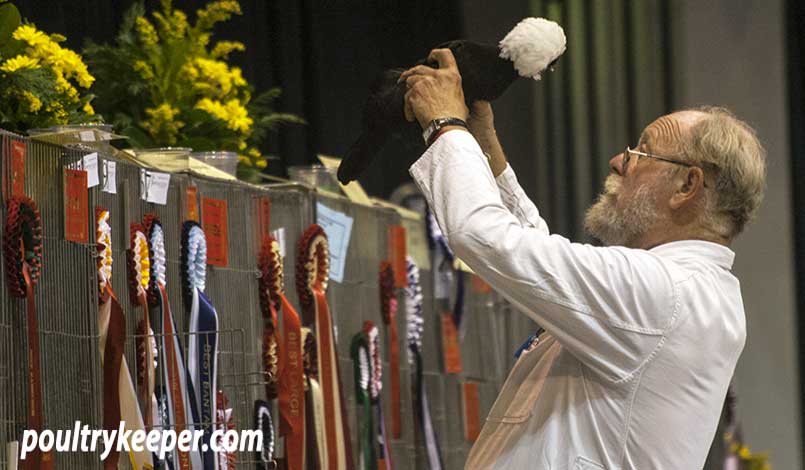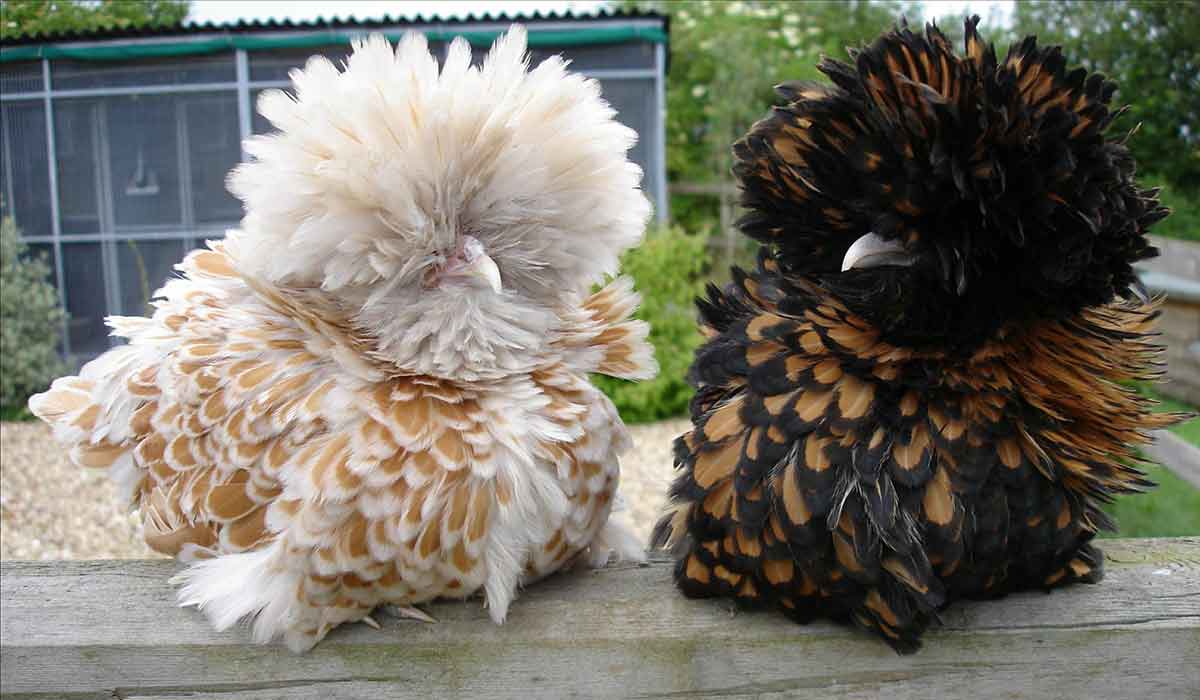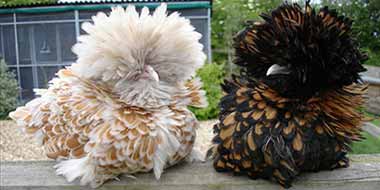
In this article, Lawrence examines the Poland Breed Standard and provides some tips and tricks for exhibiting Polands.
The Poland is another great exhibition breed and certainly one of the most rewarding; a good Poland will always make it to the championship row of the larger shows. Preparation is time-consuming and fraught with problems but is worth the effort when the bird is presented well. When showing your Poland, you should remember that a judge will look to grade your bird on 6 main points:
The crest (30 points)
Without it, the Poland is not a Poland. The crest should be high, large, full and circular. In the female, it is referred to as ‘globular’ and will be smooth. In the male, the shinier, thinner, characteristically male feathers, make the crest fall over the shoulders almost like a wig. In both sexes, it should be high in the front and extend down the nape of the neck.
The crest should be wide and at no point narrow or lacking in substance, there should be no parting in it. On the other hand, the crest should not be so heavy as to obscure the eyes or pull the skin down, causing folds over the eyelid. Needless to say, with this single feature attracting nearly a third of the points, it is vital to get it right.

Head and wattles (15 points): White crested varieties
The head should be topped by the bony knob from where the crest emerges. The way the crest sits is important for the overall shape of the head, and a poor crest will also reduce the points here.
The beak should be topped with wide nostrils, and the eyes are full and dark. The comb, if present, is of the horn type and small. Muffling is absent, with large long wattles (although not so long that they throw the head out of proportion).
Head and wattles (15 points): Other varieties
As for the white-crested, except muffling is present and wattles are absent. The muffling should be full and almost hide the face.
Colour (30 points)
Another important feature and responsible for another third of the overall points.
Colours should be solid and with no paling or other colours present. Black birds should have a ‘beetle green’ sheen. The laced varieties should be clearly laced or spangled depending on the feather type. The silver laced may have white feathers in the crest of older birds.
In the white-crested birds, the crest should be a snowy white with no coloured feathers except for the coloured band at the front, which should be the same colour as the body.
In cuckoo birds, there should be no solid colour feathers.
The Chamois (buff laced)
Buff base colour with white edging, the crest will be white at the base and tips – a pale, washed-out crest is not desirable. There should be no self white feathers. The feathers should be distinctly laced, splashed or tipped depending on their position on the body.
The Gold laced
As the chamois, except the lacing is black and the base a golden bay.

The Silver laced
As the chamois, except the lacing is black and the base silver. The self white, black and blue is a solid colour throughout.
Type (5 points)
Surprisingly, this is the lowest of the points, but your bird will be rejected without type. It should look long and sturdy. The wings should be large and tight to the body. The tail should be full, neatly spread and not upright – it is held at a lower angle than normal.
Remember that the bird should be alert and lively; a sick or lethargic bird will be disqualified. Legs should be slate or blue, with 4 toes on each foot.
Size (10 points)
Large birds should weigh 2.95 kilos (6½lb) for males and 2.25 kilos (5lb) for females. In the bantam size, males should be 680-79g (24-28oz), females 510-680g (18-24oz).
Condition (10 points)
As this breed has several inherent problems, the condition is critical to ensure healthy birds without genetic problems. Judges will be looking for health, freedom from parasites and absence of genetic faults and skin conditions such as infested eyes caused by a heavy crest.
Diseases common to Polands has further information.
Birds that are over-shown may develop stress symptoms such as ‘cage fatigue’ and become lethargic. Your bird should have been washed and cleaned before the show to present it at its best.
Serious defects
Serious defects include:
- Split Crest
- Twisted Crest
- Comb not of the ‘horn’ type
- No muffling (unless white crested black)
- Light legs, yellow legs
- More than 4 toes
- Physical deformity
- Absence of coloured band in the crest of the white-crested varieties
- Thin twisted feathers in the frizzle
- Feathered legs
- Solid colour feathers in a white crest
For further information, see the British Poultry Standards in association with the Poultry Club of Great Britain.
Exhibition Tips
- Cover D cups with tape to limit access to water – this prevents crest soiling. Give water yourself, do not rely on show stewards who do not know the breed.
- You can remove a few stubs of feathers on the legs with tweezers, but if there are too many, you can end up with holes in the shanks, which will point to doctoring your bird.
- Similarly, a few miscoloured feathers can be removed, although too many and a good judge will be able to tell.
- Washing is a necessity if you want a well-presented bird
- Tape up crests with masking tape before showing to maintain shape and prevent crest pecking if several birds are kept together
- Misshapen crests can be corrected to a degree by taping, although physical deformity will be disqualified
- Always powder your birds against mites when you return from a show
- Avoid high perches to prevent bubble foot and bent toes
- Heavy crests can cause eye damage when the weight of the crest pulls the skin over the eye, so try to eliminate this from your breeding stock. Always check for eye infections.
See 15 Tips and Tricks for Exhibiting Your Show Chickens for further tips on exhibiting Polands and other chicken breeds.


